Interesting Stuff
- Boing Boing: Possible "octosquid" discovered
This creature, apparently a half-squid, half-octopus, was found off Hawaii's Big Island. Possibly a newly-discovered species, it was accidentally sucked up into a deep-sea water pipeline from a depth of 3,000 feet. - X-Sounds
july in kreuzberg - sound art - Eyebeam reBlog: Announcement: New Wooster on Paper Book - "All My Friends Are Made Of Paper"
latest limited edition book in our "Wooster On Paper" series
This is the way i was playing pacman aaages ago and i never went beyond that cardboard point. Yosuke Ueno's version of Mario is just my kind of video game too.
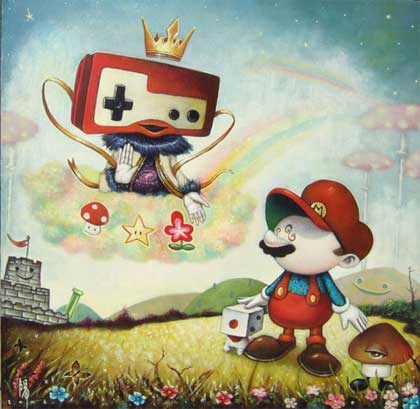
beginning The Great Adventure
Via las insolitas aventuras del pez.
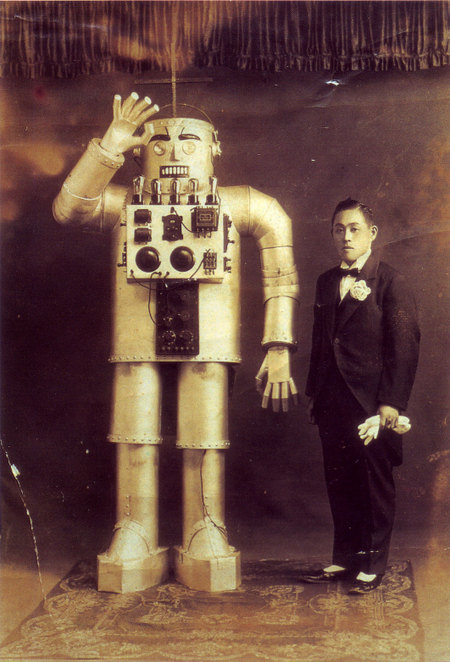
Yasutaro Mitsui with his own steel humanoid, early '30s.
Via Hugo Strikes Back (information about the picture found in Book review: Loving The Machine: The Art and Science of Japanese Robots.)
- Free Soil - Warning art
Here are the ten art projects that deal with the subject of Climate Change, - metroZones
texts from the five metroZones books listed below. The books are the results of the project "ErsatzStadt" (Substitute City). - Silicon Valley subculture of stuffed animals is the largest in the world
The Internet Furry Proximity Locator, a geographic site that plots furries by zip code, identifies Northern California as a national hotspot.
Today our home rely on a network of cables, pipelines and connections. Most of the information we have access to is passing through these "roots." ASCII-Code curtains, by Dutch designer Nienke Sybrandy, visualize the information network in a tree, using the very codes that represent text in computers, communications equipment, and other devices that work with text.
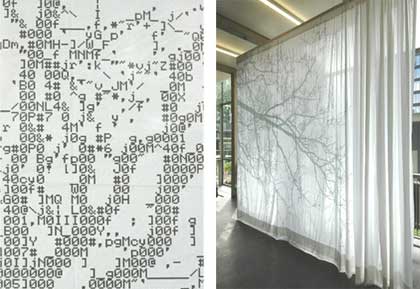
Via Beton & Garten. I tend not to read blogs written in a language i cannot understand but there are exceptions, Beton and Garten is one of them.
- Digg - Hackerspace c-base under threat of closure
help them, donate! digg hte news. i love these guys and their work - Clearing the way for the Olympics in London
'unofficial tour' to see what progress had been made clearing and demolishing people's homes and businesses + documented the industries and communities that will all be moved on by the end of June 2007 to clear the way for the new Olympic park. - Girl could give birth to her sistert;/a>
A 7-year-old girl could one day give birth to her biological half-brother or half-sister after her mother became the first woman to donate eggs to her infertile daughter. - MAKE: Blog: The Maker File: Interview with Marcell Mars
Marcell Mars. In this interview, Marcell talks about building community around free and open source software, music and art. What does geek mean as a label?
Meet one of my favourite Berliners! Christine Hill invited me last year to give a talk at the Bauhaus University in Weimar where she heads the Department Media, Trend and Public Appearance. That's how i got to know her, i then googled her name and immediately realized the extent of my ignorance when i discovered that she has been exhibiting all over the world with a very unconventional and intriguing project (or should i label it "production label"?) called Volksboutique.
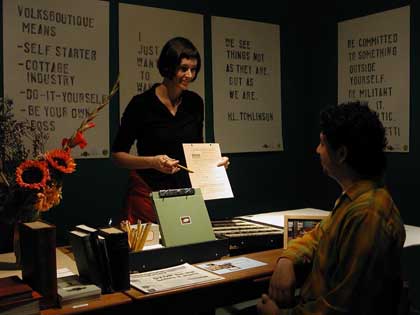
Volksboutique began as a thrift store/sculptural installation in Berlin back in the '90s when she left New York and landed in Germany. Visitors would open the door to her underground shop, tea was served, clothes were cheap and people congregated to discuss topics ranging from identity and self presentation, to weather and the effect of tourism on the neighborhood (via).
Volksboutique projects kept on evolving, surprising and questioning the audience and the art world. She franchised the boutique for Documenta X in Kassel in 1997, then abandoned her role as a salesgirl and mutated into a late-night talk-show host, a tour guide, a masseuse, a handbags and retro-looking stamp kits designer, etc. Turning everyday job into an artistic activity that could either be presented inside galleries or taken on the road inside carefully crafted trunks.
She is currently showing one of Volksboutique manifestations, Minutes, at the Venice Biennale of Art. This interview was made before the Venice art exhibition.
A book about your work "Inventory : The Work of Christine Hill and Volksboutique" has been published recently. How did it feel? Like a chapter of your professional life that had been turned?
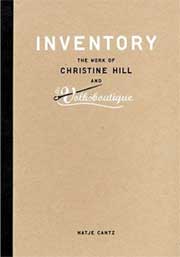 Not to invoke a too-female metaphor here, but that book was as much birthed as it was published. The compilation process was pretty strenuous and I almost fell over when my editor mentioned that "the next book will be much easier" for inability to ever comprehend ANOTHER book. But indeed, there will be another book, as soon as this month! So, I survived the first Volksboutique Inventory. But of course, having an opportunity like that one was incredible, and making the book into a project became my primary task that entire year. I like to keep order, and surveying the projects made since I really began working professionally (depending upon when that actually was) was incredibly satisfying.
Not to invoke a too-female metaphor here, but that book was as much birthed as it was published. The compilation process was pretty strenuous and I almost fell over when my editor mentioned that "the next book will be much easier" for inability to ever comprehend ANOTHER book. But indeed, there will be another book, as soon as this month! So, I survived the first Volksboutique Inventory. But of course, having an opportunity like that one was incredible, and making the book into a project became my primary task that entire year. I like to keep order, and surveying the projects made since I really began working professionally (depending upon when that actually was) was incredibly satisfying.
Initially, I thought of this book as a sort of end of year Annual Report, and was thinking of course about summing up.
I also was glad to have the opportunity to formally define what makes up Volksboutique for me, as it has often been (mis)understood as solely a second-hand shop. The book was the opportunity to show breadth, and to also underscore the aesthetic and "philosophical" stance I take. I also write a fair amount, and the book was the perfect showcase for that activity.
It was an incredibly tidy feeling to draw the line somewhere and say to myself "All this has been accomplished", but then a sort of enormous void was staring at me, as in "what now?" This is rather familiar to me after large projects.
And as I've gotten increasingly interested in libraries and other archiving systems, I am happy to be working on books that can show that interest.
Why these deliberate confusions between art and commerce?
Well, I'm quite interested in properly defining which things are assigned value. And I'm very preoccupied with what counts as labor.
This began quite practically following my move to Berlin in 1991 â" with my larger project of assimilating. It is noteworthy that I had no real permission to work here, and so I devised series of service pieces in the early 90s, where I, for example, worked as a masseuse, largely for tips. Also, that I was included in (and working for) numerous group shows all over Europe at this time, and realized that, rewarding as that is, it doesn't pay money.
This idea of merging income and art occupations culminated with opening the Volksboutique-as-shop in 1996. It was a way of claiming autonomy. It both freed me from being anyone's employee, and launched me straight into Proprietor-status, and it absolved me from having to rely on the art system to provide me with an audience. It allowed me to build a base of operations, and work from it, which is a device I've held onto over years.
My work path over years has continued to punctuate my thoughts on this, in the form of anecdote or in specific exhibition or project experience. A museum I did a project with revoked a small production fee when they discovered that the piece I had made â" a vending machine â" was turning a small profit within the exhibition itself. Hundreds of visitors to my installation at documenta X (a franchise of the Volksboutique shop, installed in the exhibition) complained loudly that this "wasn't a commercial exhibition!", missing the irony that, for example, a Jeff Wall was hanging directly opposite my store. Numerous visitors (including a reporter from The Wall Street Journal) found my $12 tour fee as part of my Tourguide? piece in New York city excessive, although that is exactly the sum charged by all tour guide agencies in the city. A museum director in Italy refused to refund my travel and production costs for the installation, barking at me that I was "lucky to be in Italy".
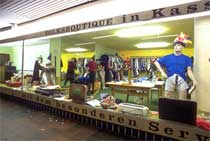
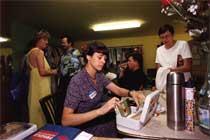
Volksboutique Franchise, 1997
On the one hand, we have art fairs and Sotheby's auctions reminding us all the time about the financial inequalities or excesses of the art system, but then, on the other, we have puritan calls for the work to be freed of economics so that it can exist in some reality-free bubble. And I disagree with both of these extremes.
Of course, I am isolating these experiences to underscore this particular pointar point. It should not be misinterpreted that my entire work path has been a litany of complaint or abuse. To the contrary. Most artists I know find themselves being pushed forward by "mistakes" or such experiences, and I am no different. Hitting a point of adversity, whether within one's own process or from the outside, pushes things forward.
Basically, I identify with being a working artist - I work hard in order to live from this and live AS this. And it's important to me to feature that in projects. And it is important that that include financial aspects.
Of course, when I am involved is larger scale projects â" which I call "Organizational Ventures" â" that contain large amounts of administration, preparation, and on-site labor, I am often asking myself what I am trying to prove to myself by creating these insanely confounding schemes. It IS the addition of chaos, of overwhelming-ness, of over-stressing productivity that ends up defining many of these projects.
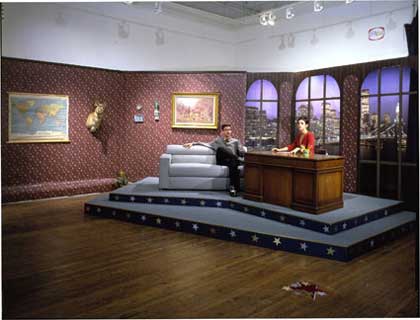
Pilot, 2000
Do you perform or role-play with Volksboutique? How do you differentiate one from the other?
It is good that the the word "performative" has entered the general art vocabulary, because it rescues work like mine from being labeled as Performance Art. I am extremely averse to theater, because I don't want to see a simulation of life. I want life. I want things real and in real time. And there is always going to be that unfortunate leap the mind makes when hearing the phrase "performance art" that conjures the stage whisper, or someone setting themself on fire. So I don't consider myself to be performing in the sense that we understand "acting" or staging. But I DO find that the entire thing is about performance, in terms of what in German is the word Leistung. And I do have a certain public persona that is in the work (and probably in my teaching as well). It is a part of my own personality, not something that is assumed, but it is also specific to certain projects that contain an extroverted element. Initially, my labors in the Volksboutique were specifically about pointing directly to the fact that this was an occupation. Something all-consuming, that required a sweat to be broken. And about clarifying that my own person/a was the guide through this set of ideas. This is also a way of addressing accountability and responsibility. Projects of mine require participation of various levels by viewers. How much they can access has in part to do with how they approach me as the representative of any given work. I feel this is a fair exchange, similar to any in a shop transaction.
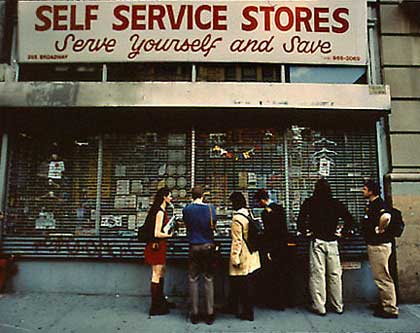
Tourguide?, 1999
Which criteria guide the choice of the identities you adopt in the Volksboutique performances?
I spent one year at a university before switching to an art school, and while I was there, I remember being astonished at the number of extremely focussed majors some people had. I had no idea that these occupations existed. In high school, I was told by those in the position of advising me that I would be a good artist or a good lawyer. (I will assume because I was generally considered a "creative type" but I was also extremely loud and opinionated.) My step-mother thought I should become a dental hygienist. Upon graduating from art school, though my occupation as artist was never really something I questioned, I realized I missed many aspects from other occupations. I remain infinitely curious, for example, about office culture, although I've never worked in a true cubicle-zone ever. My initial incarnation as shopkeeper at the Volksboutique was mostly informed by my taking German service culture to task, not to mention wanting to define publicly what I felt was the role of the artist in the society, and that this was a service providing role. Thereafter, I began investigating which jobs would best illustrate my preoccupations. I am particularly interested in librarians now, for example.
I suppose it is redundant to mention these works also point out my femaleness to an extent. Either I have chosen to take on some stereotyped female roles (shopgirl, librarian) or I am intentionally trying out things that fewer women end up in (late night talk show host).
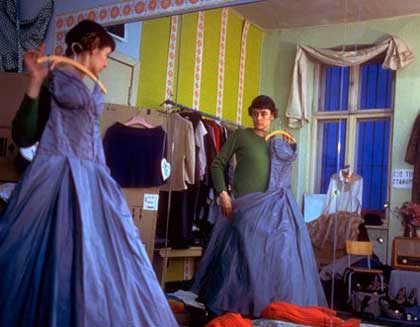
Volksboutique, 1996-1997
One of the more reproduced photographs from the Volksboutique store shows me holding up an actual debutante's ball gown in a wall-sized mirror. There was a fair bit of sniping regarding that image, that it was self-serving or narcissistic, etc. But what it was was my trying something out that interested me. Sizing it up, putting it on.
The aesthetic of the Volksboutique object is very peculiar. What inspired it?
 The name Volksboutique stems from the VEB, or VolksEigenen Betrieb, which was the socialist term for collective ownership and industry in the GDR. I moved to Berlin Mitte in 1991, and it was a profoundly different aesthetic experience than today, not to mention from that which I was accustomed having grown up in the States. The remnants of the GDR were everywhere, literally cast out on the street in piles day by day. I wandered the streets daily hauling in everything I could physically transport home. A store called "Dumping Kuhle" sold off stockpiled VEB products that were suddenly rendered valueless. That was the environment I lived in, and so it naturally entered my work.
The name Volksboutique stems from the VEB, or VolksEigenen Betrieb, which was the socialist term for collective ownership and industry in the GDR. I moved to Berlin Mitte in 1991, and it was a profoundly different aesthetic experience than today, not to mention from that which I was accustomed having grown up in the States. The remnants of the GDR were everywhere, literally cast out on the street in piles day by day. I wandered the streets daily hauling in everything I could physically transport home. A store called "Dumping Kuhle" sold off stockpiled VEB products that were suddenly rendered valueless. That was the environment I lived in, and so it naturally entered my work.
However, this is not exclusively a GDR nor Ostalgic thing. My residence in Brooklyn had me obsessed with visual elements I found locally, for example, my studio there is housed in a former pencil factory. Many elements invoke a hand-made aesthetic, and I have a predilection for cast-off objects. I collect 50s office furniture, vernacular signage, manual typewriters, and have a mini-museum of vintage stationery products.
Volksboutique is to a large extent about examining concepts of âvalueâ in our culture and re-investing discarded appurtenances with meaning and use. Iâm trying to point viewersâ attention to specito specific objects and events in life that risk being overlooked as being too quotidian or too common.
One of the mottos of Volksboutique is "Make the most of what you've got." Are there examples in your life when you had no choice but "make the most of what you had"?
I think I could answer this many ways. In my family, there is a particular tic to be constantly striving for a point of "readiness" or "departure" that is pretty unattainable, and can be frustrating. What I mean here is, that "work" can only get done once every little other thing is done â" dishes washed, clothes straightened, recycling out, checkbook balanced â" rendering a clean slate so that this WORK can begin. But this is a state that will never really be attained! I realized pretty early that rather than waiting for this ultimate constellation or alignment of graces, or whatever, that I simply had to jump in and work with whatever was at hand. This could easily be seen in financial terms, that when XXX stage of financial security is arrived at, THEN XXX can be achieved. Rather than waiting for an impossible or utopian situation to suddenly arise, better to get to work and create a better situation. I mean, I moved to Berlin with no permission to be here, not speaking the language, and with really no obvious skill set that differentiated me from anyone else...and so working within these limitations became my project.

Volksboutique Accounting Archive, 2002
With regard to being a practicing artist, especially since entering the teaching community, there is this misunderstanding to dispel that one entered an art career with other cards than anyone else. What I mean here is that I went through the same channels that anyone would: art school, move to urban environment, work, dialogue within the art system. People are not born with cards optioning them to art careers, (or any careers). There is no mystical thing that suddenly bestows an artist with a career. An artist works and finds him/herself in the midst of it.
I also understand art making to be less about the invention or construction of new things, but more about the close paying attention to and realignment of existing things.
What is Christine Hill doing when she's not keeping the shop? I'm particularly curious about the work of your students.
Well, I make a lot of lists. And I am a master procrastinator. It is sort of a job in itself. But yes, one of the larger re-structurings of my work life since 2004 is that I teach full time at the Bauhaus University. I chair the department "Media, Trend and Public Appearance" within the media faculty. This is something that sort of serendipitously presented itself to me, and turns out to have been fairly revolutionary for me. I am lucky that teaching is less a diversion from what I normally would be doing, rather it is a pretty natural extension of what I do. And though it has taken some getting used to in terms of the organization of my working time, I find myself impressed and inspired by my students to an amazing degree. The math for embarking on a career as an artist is not necessarily in one's favor, and the culture â" even if we happen to be in some art market boom right now â" doesn't necessarily jump over itself in appreciation for the artistic occupation. So these people are incredibly brave, and I appreciate them following their instincts, and their being uncompromising about what they demand from their lives. And it is there that I can offer the most guidance. I am not necessarily sitting with them teaching them software or how to patina something to a particular finish. More so, it's training them for the long fight. To instill in them a rigor, so that they can go out with that in their toolkit. I'm not trying to scare them, but I am trying to explain to them what will be required of them in terms of discipline and focus. Furthermore, I am myself a huge fan of good work, and when my students come up with good projects, I'm just completely invigorated by that.
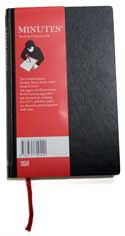 Can you tell us something about the work you're preparing for the upcoming Biennale of Art in Venice?
Can you tell us something about the work you're preparing for the upcoming Biennale of Art in Venice?
Well, that aforementioned Second Book is the main contribution for Venice. It is entitled Minutes (as is the entire piece for Venice) â" referring to detail, minutae; the passing and accruing of time; and of course, taking meeting minutes, the tallying of progress.
The book as an object is patterned after a calendar/datebook. In considering what one could/should put in an exhibition like Venice, there seemed to be pressure for Big Project, and I sort of dislike the notion of the masterpiece or opus. I like the continuum, that the machine is humming, that things are ebbing and flowing insofar as industry is concerned, and that many factors contribute to the so-called Process. This is most easily evidenced by a glimpse into my own datebook. So, the piece for Venice speaks to that...how my (or the mind) is organized, and what things are in there, and they can be very small things, and that it is something about growth via accumulation. And organization. I like that haircut appointments reside in the same space as big deadlines, and so-called Events of Note.
"Minutes" features work since the Inventory book, and texts I've written on them. There is a marvelous essay at the beginning by the author and musician (and my friend) Rick Moody. The publication was designed by the Leipzig-based Markus DreÃen (as was Inventory) and he is simply a masterful talent. Our collaboration is one that I am incredibly proud of.
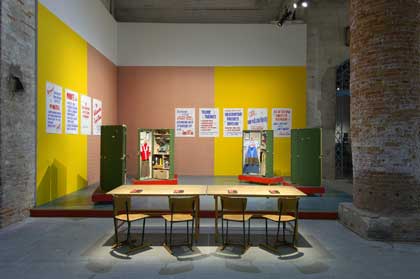
Minutes, installation view at the Venice Biennale, 2007
In addition to the publication, which is displayed in a sort of reading room environment, there is an installation of my Trunk Show in the Arsenale. These are a pretty spot-on manifestation of how my work and thought process organize themselves. The idea for this trunk system came from a conversation with my sister a number of years ago. She had visited a 60s submarine-turned-museum in Hawaii, and was extolling the wonders of how the interior worked...the attention to detail, how every little thing had its place in order to economize space, etc. She exclaimed "It was SO Volksboutique!". I realized that at that time, it wasn't particularly that any Volksboutique pieces were like this, but that my sister has such a good understanding of how my mind works, that she knew I would identify with this sort of organizational system. And so, the trunks were about making a physical representation of that. They isolate a five day work week into 5 governing tasks (Accounting, Management, PR, Production and Reception) and there are the complete accouterments for each of these occupations in each trunk. They are about economizing space and also rendering these tasks mobile.
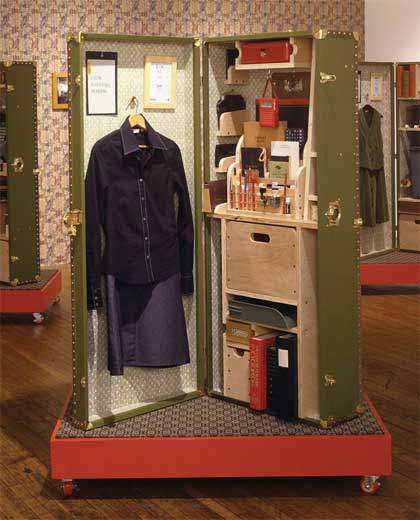
Accounting Portable Office
My Brooklyn studio is right alongside the workspace of Booklyn â" a bookmaking artist alliance that I've worked closely with since having been in New York. Particularly my friendship and collaboration with Mark Wagner â" who manufactured these trunks as over-dimensional, exploded "books" â" is important to me, and the show pays homage to that.
Name us 3 to 5 artists whom you think should get more attention from the public.
Well, I will preface this by saying that these are artists I admire and am inspired by, and am lucky enough to be friends with.
But I am not inferring that they are necessarily under-respected spected or underexposed in any way. But it is certainly excellent if even more people learn about them, because they all do amazing work. I notice that they are all mostly based in New York, which certainly means I need to get out in Berlin more!
Allison Smith (The Muster and Notion Nanny.)
Nina Katchadourian
J. Morgan Puett
Pablo Helguera
Michael Rakowitz.
Thanks Christine!
- selectparks - Seriously Fun.
overview for those a little lost on so-called Serious Games. Alongside it offers a few healthy perspectives from the likes of Frasca, Bogost and Molleindustria - Putting people first » Nicolas Nova lectures in Turin, Italy - 12 July
Nicolas Nova will give a critical overview of the evolution towards âhybridised environmentsâ. Nik rulzz! - Bright outlook for solar cells (July 2007)
Nanotechnology could transform solar cells from niche products to devices that provide a significant fraction of the world's energy
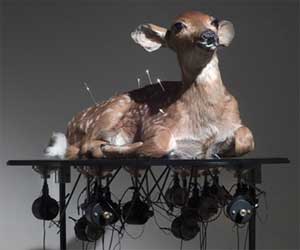 After a friend died from melanoma, Chicago-based artist Joseph Kohnke realized that even small imperfections on the surface of the body could consume oneâs entirety, and how markings on the skin can act both as camouflage â" increasing chances of survival â" as well as harbingers of death.
After a friend died from melanoma, Chicago-based artist Joseph Kohnke realized that even small imperfections on the surface of the body could consume oneâs entirety, and how markings on the skin can act both as camouflage â" increasing chances of survival â" as well as harbingers of death.
With Marked, Kohnke explores skin as the indicator of well-being.
The installation consists of a medical examination table with a conveyor belt containing photographs of the artist's skin. A scanner scans the photos puncturing the paper whenever a mark that could be seen as a flaw or as life threatening is spotted (freckle, scar, mole.) These punctures are then fed through a vacuum system similar to a player piano employing 14 tuning forks transforming them into spatial sound. In the next room, a taxidermied fawn receives the same signals, as lights pop out from beneath its fur.
Some of Kohnke's works are currently on show at the Art Lab gallery in Beijing's 798 art district.
Thanks Joseph Magliaro.
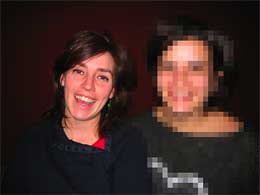 Bonjour les enfants, here's another project seen at the RCA's Great Exhibition in London.
Bonjour les enfants, here's another project seen at the RCA's Great Exhibition in London.
With IDPS (IDentity Protection System), interaction designer Miquel Mora is proposing a new way to protect our visual identity from the invasion of ubiquitous surveillance cameras. He had a heap of green stickers that could stick to your jacket. Or anywhere else. The sticker blurred your image on the video screen.
"With the IDPS project I wanted to sparkle debate about all the issues related to identity privacy," explains Miquel. "Make people think about how our society has become a complete surveillance machine. Our identities have already been stored as data in many servers ready to be tracked. And our self image is our last resort. So we really need tools to protect our privacy. We need tools that can allow us to hide or reveal our visual image. We must have the control over it."
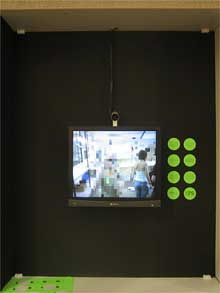 "For example in one scenario a girl is wearing a tooth jewellery with IDPS technology embedded. So when she smiles she reveals it and it triggers the camera to protect her. With IDPS users can always feel comfortable, knowing that with a simple gesture like smiling, they are in control. The IDPS technology could be embedded in all kind of items, from simple badges to clothes or jewellery. For the working prototype I'm using Processing to track the stickers and pixelate the image around when it founds one."
"For example in one scenario a girl is wearing a tooth jewellery with IDPS technology embedded. So when she smiles she reveals it and it triggers the camera to protect her. With IDPS users can always feel comfortable, knowing that with a simple gesture like smiling, they are in control. The IDPS technology could be embedded in all kind of items, from simple badges to clothes or jewellery. For the working prototype I'm using Processing to track the stickers and pixelate the image around when it founds one."
Couldn't help but ask Miquel how visitors of the exhibition reacted to his project, are they still bothered by surveillance cameras these days?
"I think people like it first because it's fun to play with but then everyone says that yes, we should have tools like that to protect our privacy. And although everyone is used to surveillance cameras all wish they could have something like this.
I need to say that there have been few people that the first thing they said is that technology would be perfect for terrorists! But I guess this is like any other technology, what is bad is the way we use it."
Thanks Miquel!
- culiblog » Lab meating Friday food, art & science snacks & symposium
symposium on the subject of food, art and science. Itâs going to be an exciting event with all that lab meat, ethics, art and highly controversial snacking. - Earplug provides steer-by-tongue control
A device that detects ear-pressure changes â" to determine how a person is moving their tongue â" should let people with extremely restricted movement control a wheelchair or computer more easily. - Santiago Sierra
CONCERT FOR A DIESEL ELECTRIC PLANT - Is it a bird? Is it a plane? No, it's a flying artist
Artists Airshow - Sniff wins prize for ‘Design for all’ · Touch
Sniff is a toy dog that gives feedback through sounds and vibrations on tagged objects that comes close to his nose. - Elixir News | British company grows living skin
A British company claims it has grown the "first artificial living skin graft". - Boing Boing: Cory podcasts Bruce Sterling's "The Hacker Crackdown"
a 1992 book that recounts the events that led to the founding of The Electronic Frontier Foundation - Radar Men From the Moon - Chapters 9 - 12 (Videos with Bibi)
Radar Men from the Moon, aka Planet Men from Mars, (1952): directed by Fred C. Brannon, starred by George Wallace, Aline Towne, Roy Barcroft, William Bakewell and Clayton Moore. (167 min in 12 episodes). Article, buy the DVD - Modern Mechanix » Metal Diving Suit Developed
Hand-operated grappling irons are a feature of the suit. hilarious! - Les curiosités médicales du musée Dupuytren
Le musée, situé 15 rue de lâEcole-de-Médecine, est ouvert au public du lundi au vendredi de 14h à 17h.
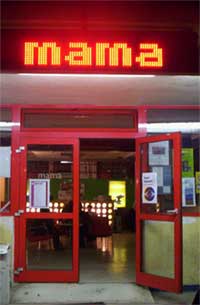 Monsieur Marcell Mars from Mama has invited me to Croatia so that's where i am heading today.
Monsieur Marcell Mars from Mama has invited me to Croatia so that's where i am heading today.
On Monday, i'll be giving a talk in Rijeka, at the Molekula center.
Then back to Zagreb on Tuesday for another talk at Club Mama. Apparently, i will be talking about this which looks quite confusing but is very probably reflecting what my talk will be like: my poor lovely white computer crashed (i learned the meaning of "backup" in the process) and preparing a presentation has gone from "i'll do that 10 minutes before the conference" to "Zut! it will take me aaages to find those images for the slides."
The talk is part of g33koskop, a program which explores the scope of geekdom... anything geek... projections, selections of online videos, talks, discussions, reading groups, etc.
In case you have some time to kill in front of the screen, here are some vids for your personal enlightenment and hopefully pleasure.
Adam Zaretsky´s just announced a 3 part documentary about his VivoArts lab, in particular the last one which focused on transgenic quail and pheasant embryology.
Related: Adam Zaretsky on Future Body (part 1 and 2)
"Videogame Violence & Effects on Youth" is a documentary directed by Edmund Wong, a graduate student at San Jose' State University (via videoludica.)
Part 1 (Introduction & Background on Games)
Part 2 (Mortal Kombat & the ESRB), 3 (Doom & the Columbine Massacre), 4 (Addiction and GTA Controversy), 5 (California Videogame Law), and 6 (Causation & Correlation. Final Thoughts.)
A couple of weeks ago i was at the MediaLab Madrid to spy on the Interactivos? workshop. Its theme was magic and illusion which i found very witty. Now that everyone is getting their hands dirty at interactivity, it has lost some of its charm and mysteries. Interactivos? invited the participants to build software pieces and interactive installations which can propose a rethinking of the usual scenario in magic tricks, marked by a very clear separation between the wizard and the spectators. The results were very impressive and i'll write more about it later.

Pablo Valbuena's Augmented Sculpture v 1.0 was probably one of the most mesmerizing pieces. Best is to start with the video. All the video footage is recorded directly from the installation, no post-prod' trick!
The piece investigates space-time not only as a 3D environment, but as space in transformation revealed by two layers that overlap each other:
- the physical layer, which controls the real space and shapes the volumetric base that serves as support for the next level.
- a virtual projected layer that allows to control the transformation and sequentiality of space-time.
The blending of both levels gives the impression of physical and transformable geometry. The orverlapping produces an euclidean 3D space augmented by a transformable layer that Pablo can control to alter multiple dimensions of space-time.

These ideas come to life in an abstract and geometric envelope, enhanced with synesthetic audio elements and establishing a dialogue with the observer.
I thought the piece called for some questions to Pablo Valbuena:
What is your background? Where do you come from?
I was born in Madrid, where I studied Architecture, after finishing my degree I was looking for some tangent fields related to architecture that were more experimental, so I started developing architecture for videogames, films, and digital architecture as a concept designer.
After some time working for several studios around the world I have recently started to focus on personal research working as an artist, although probably you can see a bit of everything related to my previous background in my present work.
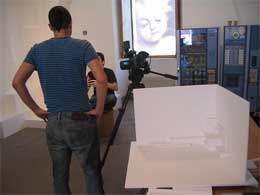 What was/were the biggest challenge(s) you encountered while working on this installation?
What was/were the biggest challenge(s) you encountered while working on this installation?
This piece was developed during the Interactivos? workshop at Medialab Madrid.I just had two weeks to produce it, that was for sure a big constraint, thanks to the help of some collaborators we managed to finish it.
Previously to the workshop I had a small scale model done where you could see how the idea was working. That solved most of the doubts I had of how the installation was going to be experienced.
The piece works overlapping two layers of space, a physical one and a
virtual one projected on top of the first. The small model was a bit difficult to adjust and scaling it up multiplied the problem and brought other issues, in the end the most difficult thing was adjusting the geometry (physical and virtual) of the two layers to make it fit. The optical aberral aberration of projectors and the imperfections of dimensions made it difficult but finally I found some ways of solving it. It was definitely a key point to solve, because it is what gives life to the piece, the illusion that everything you see is part of the same physical object.
Can you tell us something about the way the installation works technically?
The installation is very low-tech in a way, which is something I really like about it. The most high tech device used is a projector, and in the actual technological race projection technology seems to be pretty old, it is something everyone is used to see.
I like this idea of not being on the edge technologically. It really seems that we have this hunger of producing new technologies for the sake of the new, not for what technology can do. The interesting part comes from the way you use the tool, or the ideas you want to speak about, not from the tool itself.
This is why I tried to keep it as simple as possible. We have been studying making the piece interactive to the observer. And this brought the argument of what kind of interaction should be. From my point of view, in this piece scale is going to be much more important in terms of interaction with the observer than any technological
trick you can play with. The way the observer is going to walk around the piece and discover it is going to produce much stronger impressions than any other reaction of the piece. Said that I may try other ways of interaction, but just in case it strengths the piece, not for the sake of it.
I would say that the interface with the observer should be more related to the idea of "promenade architecturale" from Le Corbusier than a more direct action/reaction sensor interface. For instance there is a huge difference of experiencing the installation live walking around it than watching it on video. This is the first piece of a line of work I am going to continue, the next step is going to be a bigger installation in a public urban space that I am currently prototyping and hopefully should be much stronger in terms of interaction through scale.
Thanks Pablo!
Related: Interview with Marcos GarcÃa from MediaLab Madrid.
Back in Berlin with a long list of exhibitions to check out, a house that shouts "wash me! wash me!" and very little time on my hands. This afternoon i went to fugly Potsdamer Platz to see Art Scope - Interface Complex - Contemporary Art from Japan und Germany.
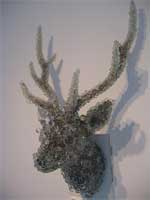
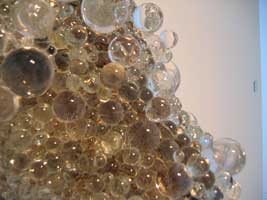
Some very nice works. Here's my pick:
The cervus nippon yesoensis is an Eastern Asian deer species one can find in many areas of the world, from animals that have escaped or been resettled.
Japanese artist Kohei Nawa hunted his deer on internet search engines, and acquired it by online auction. Part of the PixCell series, the stuffed deer head has been covered with glass prisms and marbles. The object retain its original qualities, but it acquires a second skin - a "light envelope". In this way, Nawa shows his viewers to the particular qualities of the digital age and demonstrates how much the reality of things depends on perception.
Art Scope - Interface Complex - Contemporary Art from Japan und Germany runs until 9 September 2007 at Daimler Chrystler Contemporary.
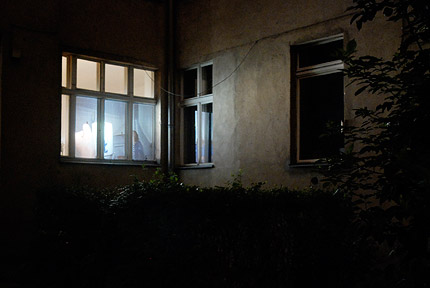
The Average Home is a growing network of mini-galleries based in people's homes, initiated by Arne Hendriks, Katharina Birkenbach and fellow gallerists.
The galleries consist of a slide projector, a window with some sort of screen and the public space around the home. The galleries all show the same image during a certain time, currently a photo by Romanian artist Mona Miclea.
Marti Guixé opened in Barcelona on Wednesday, Katharina yesterday in Berlin (pictured above) and today will be Tokyo. Upcoming are Tel Aviv, Stockholm and Bucharest.
More average homes.
- BACKJUMPS - Urban Communication and Aesthetics
tonight i m in berlin, tonight i m in berlin. can't wait to be home again! - VIDEOLUDICA - Luca Volonte vs. Molleindustria
Il gioco-provocazione di Molleindustria, Operazione Pretofilia, ha suscitato la rabbia di Luca Volontè, capogruppo dell'UDC alla camera, il quale si e' apparentemente mobilitato per oscurare il sito.
- VH1 Game Break: Old School: Atari-Sotheby’s Auction
An extensive archive of original marketing materials (as detailed below) from the âGolden Ageâ of Atari, ca. 1981 to 1983, comprising more than 2,000 items of widely varying sizes and formats,
![]() According to what i have eaten in the morning i am either a bit cynical about the real impact of activist projects or totally enthusiastic about their objectives and methods. Most of the time i am both. It also depends on the cleverness of the activists themselves. I still have to find any trace of ungainliness when it comes to The Institute for Applied Autonomy. The anonymous activist group believes in the importance of disseminating knowledge, encourages autonomy, and develops methods of self-determination through artistic expression and application of military-like technology to the topics of criminal mischief, decentralized systems and individual autonomy.
According to what i have eaten in the morning i am either a bit cynical about the real impact of activist projects or totally enthusiastic about their objectives and methods. Most of the time i am both. It also depends on the cleverness of the activists themselves. I still have to find any trace of ungainliness when it comes to The Institute for Applied Autonomy. The anonymous activist group believes in the importance of disseminating knowledge, encourages autonomy, and develops methods of self-determination through artistic expression and application of military-like technology to the topics of criminal mischief, decentralized systems and individual autonomy.
You might have read or seen one of their pamphlet-distributing or spray painting robots or participated to the protests during the 2004 US presidential campaign, by using their TXTmob system.
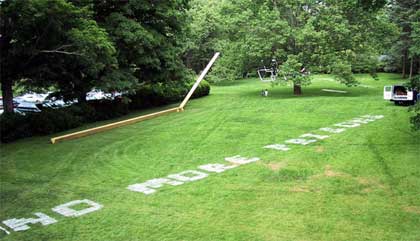
StreetWriter
âThe Institute for Applied Autonomy (IAA) was founded in 1998 as an anonymous collective of artists, activists, and engineers united by the cause ofcause of individual and collective self-determination.â Why did you decide to stay anonymous? How much does that anonymity serve your objectives? Is it part of a strategy?
Initially, we embraced anonymity as a defensive tactic, as many of our projects exist in a legal grey area. Working collectively and anonymously seemed natural to those of us with backgrounds in direct-action politics and the hacker and cypherpunks communities. Groups like Cult of the Dead Cow and native Hawaiian activists Hui Malama gave us a model for action that was both publicly engaged and effectively anonymous.
Weâve also found anonymity to be a useful tactic in dealing with the press. Many journalists seem to be more interested in writing about artists than about the art they create â" this is particularly true when the work has explicitly political content. By refusing to provide any personal information about ourselves, we control the kinds of narratives that journalists create about our work and the issues it engages.
iSee enables users to avoid CCTV surveillance cameras. Some UK-based artists working on ideas of counter-surveillance for the broad public have discovered that in fact most people are totally comfortable with the idea of surveillance in public space. Have you noticed anything similar when you have deployed the project in several cities, both European and American? Did you notice different attitudes towards surveillance according to the country?
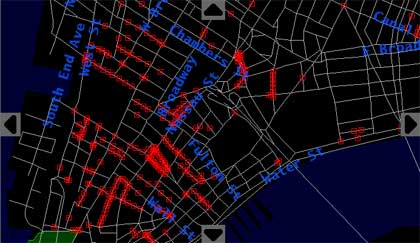
Itâs true that many people are comfortable with surveillance of public space, especially when confronted with the usual choice between privacy and security. With iSee, we tried to subvert (or at least complicate) this binary. Initially this meant focusing on the mechanics of surveillance, pointing out that in practice CCTV surveillance has had very little impact on actual crime and that it is subject to the biases of system designers and operators, which means it often gets used to ogle women and single out youth and minorities for scrutiny. Ultimately though, the camera-avoidance part of the project became less significant than the data-collection and visualization aspects. We held workshops in which participants used our tools to create interactive maps of their cityâs surveillance infrastructure. This activity asks a very different set of questions than simply âDoes CCTV make you uncomfortable?â Instead, it points to the lack of any kind of baseline data about surveillance. Before we can have an intelligent conversation about CCTV surveillance, for example, it would be nice to know how many cameras are in operation, where they are, who owns them, etc. For the most part, this information simply doesnât exist â" In most countries, cameras are put up by individual building owners and their data is increasingly managed by third-party private companies. In effect, we have an emergent infrastructure of video surveillance that is growing on an ad-hoc basis, without any public discussion or oversight. The only way we have any information about the number and location of surveillance cameras is through the efforts of grassroots activists and concerned citizens.
Apart from surveillance and counter-surveillance, what are the issues you find worth fighting for/against?
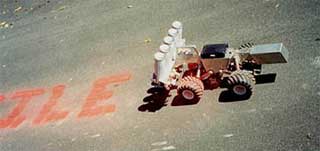 Weâre generally interested in the intersection between technology, public policy and social control, and with building systems that facilitate freedom of speech and public acts of dissent. This encompasses a number of related issues including surveillance, public space, and law enforcement. Weâre also extremely interested in the ways that technologies and scientific knowledge are produced, which has lead to an ongoing engagement with academic research labs and with the funding agencies that support them.
Weâre generally interested in the intersection between technology, public policy and social control, and with building systems that facilitate freedom of speech and public acts of dissent. This encompasses a number of related issues including surveillance, public space, and law enforcement. Weâre also extremely interested in the ways that technologies and scientific knowledge are produced, which has lead to an ongoing engagement with academic research labs and with the funding agencies that support them.
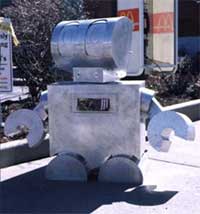 Your robots have a very peculiar look. Little Brother has a cute metal tin look, while the GraffitiWriter just looks efficient. What or who guides the way you design robots?
Your robots have a very peculiar look. Little Brother has a cute metal tin look, while the GraffitiWriter just looks efficient. What or who guides the way you design robots?
We employ what might be called a kind of âtactical aesthetics,â in which aesthetic decisions are determined by the intended goals of a particular project. Little Brother was intended to distribute subversive literature to unsuspecting audiences, so we tried to make him really cute and engaging.
GraffitiWriter on the other hand leveraged techno-fetishism to confer a kind of legitimacy to robot-mediated criminality, so it needed to look like a âcoolâ robot. While functionally similar to GraffitiWriter, Streetwriter was intended as a clandestine graffiti writing machine so it looks fairly innocuous, appearing to be an ordinary cargo van. The latest version of StreetWriter, which we call SWX, was intended for the very specific purpose of infiltrating the 2004 DARPA Grand Challenge which lead to a particular kind of sleekness in
the design, with a glossy white exterior and laser-cut aluminum logos.
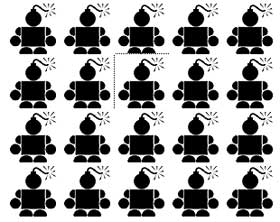 GraffitiWriter invites the public to spray paint graffiti on the pavement. How much are people ready to forget that they are well-behaved citizens and contribute to this piece of âstreet artâ protest? Which kind of messages do you receive? Mainly love messages or rather angry complaints?
GraffitiWriter invites the public to spray paint graffiti on the pavement. How much are people ready to forget that they are well-behaved citizens and contribute to this piece of âstreet artâ protest? Which kind of messages do you receive? Mainly love messages or rather angry complaints?
Youâre referring to our âRogues Galleryâ project in which we took our GraffitiWriter robot to public spaces across the United States and Europe and offered it for use by the general public. One of the things that was so interesting about this project was that so many people were wiling to participate! Weâd simply show up unannounced in a public park or city center, drive the robot around, and invite people to use the machine to spraypaint messages on the ground. Virtually everyone we encountered was willing to give it a try, even though what we were doing was clearly illegal. To us, this seemed to be an interesting inversion of the usual narratives about technology extending human abilities. With Rogues Gallery, the robot overcame certain kinds of social conditioning not because of its mechanical capabilities but simply because it was seen as legitimate, based on the assumption that anyone possessing a robot represented some large research institution which probably had the ârightâ to spray its messages on public space, rather than simply bsimply being a couple of crazy people who built a machine in their garage. Imagine if we had tried the same experiment without a robot, using only a few cans of spraypaint â" no one would have participated because the action would have been clearly understood as an illegal act of public defacement.
What are the best locations to unleash a contestational robot?
It turns out you can release them almost anywhere. Although, Iâd probably be careful around airports these days.
With the kind of public art/activist projects that you develop, things might not always go the way you foresaw. How much do you learn from the way users behave and interact with your pieces? Could you give (an) example(s) of unexpected and unwelcome/delightful experience?
Because our work mostly happens in uncontrolled environments, weâre almost always surprised by the way our projects unfold. The Rogues Gallery project we just discussed is a good example â" our initial idea for the GraffitiWriter robot was to be able to spraypaint in places that are too dangerous for human activists, like banks, shopping malls, and government buildings. We had anticipated that if there were any problems with authority the robot would be sacrificed rather than the person. However, during its initial public deployment on the steps of the U.S. Capital Building, the robot and its human operators were detained by one of DCâs finest. Surprisingly, the presence of the high-tech looking robot confused what might have been a straight-forward arrest. At that point in 1999 it was unthinkable that juvenile delinquents would have a robot at their disposal. We probably fell between the categories of having to file a complicated report or needing to call for backup, so the officer let us go. In that moment we discovered that the robot functions best not as a covert writing machine but rather as a way to engage the public in participating in subversive activity using a powerfully legitimizing technology. Thereâs a bit of the Stanley Milgram experiment here, only using robots rather than lab coats as the symbol of legitimate authority.
Similarly, with TXTmob the SMS-broadcast tool we created for use by
protesters at the 2004 Democratic and Republican National Conventions, we found many examples of unexpected use. Because we worked closely with several activist groups to design the system, we had a pretty good idea of how it would be used by protesters. However, it quickly became clear that it was also a really important tool for journalists covering the protests. Because so many of the actions were spontaneous and short-lived, occurring all over the city (for example, groups of demonstrators mobbing convention delegates who were spotted eating at local restaurants), there was virtually no way for sympathetic journalists to know what was going on. Once the journalists started using the SMS system, however, they were able report on all kinds of sit-ins, street theater, and demonstrations. As a result, the quality of reportage for the Republican National Convention in New York was better than weâve seen for most recent demonstrations in the United States.
Terminal Air is a visualization system developed for mapping the movements of planes used in the CIA extraordinary rendition program. How can the project help counter the extraordinary rendition program practice? Has anyone ever tried to silence the project?
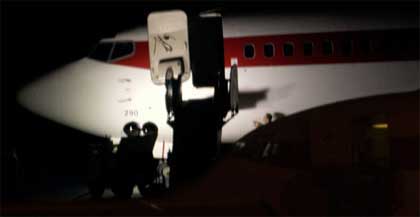
There are several components to the Terminal Air project. It is primarily an installation that examines the mechanics of extraordinary rendition, a current practice of the United States Central Intelligence Agency (CIA) in which suspected terrorists detained in Western countries are transported to so-called âblack sitesâ for interrogation and torture. Based on extensive research, the installation imagines the CIA office through which the program is administered as a sort of travel agency coordinating complex networks of private contractors, leased equipment, and shell companies. Wall-mounted displays track the movements of aircraft involved in extraordinary rendition, while promotional posters identify the private contractors that supply equipment and personnel. Booking agentsâ desks feature computers offering interactive animations that enable visitors to monitor air traffic and airport data from around the world, while office telephones provide real-time updates as new flight plans are registered with international aviation authorities.
Seemingly-discarded receipts, notes attached to computer monitors, and other ephemera provide additional detail including names of detainees and suspected CIA agents, dates of known renditions, and images of rendition aircraft.
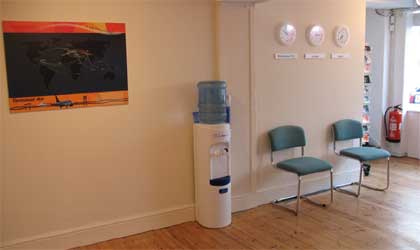
The project was inspired through conversations with extraordinary rendition researcher and author Trevor Paglen (Torture Taxi: On the Trail of the CIA's Rendition Flights â" Melville House Publishing). Data on the movements of the planes was compiled by Paglen, author Stephen Grey (Ghost Plane: The True Story of the CIA Torture Program â" St.Martin's Press) and an anonymous army of plane-spotting enthusiasts.
The main goal behind the Terminal Air project is simply to raise awareness about extraordinary rendition, to call particular attention to governments, airports, and private contractors who are complicit in its operation, and to recognize the ongoing efforts of various journalists, activists, and citizens who are continuing to uncover and document it.
Weâve also amassed a large database of flight log information, which we make available to the public. So far, no one has tried to interfere with the project (indeed, public reception has been quite positive), but itâs still in the early days â" the first installation of the project was in March, and we anticipate a few high-profile shows this fall, so weâll see what happens.
Any upcoming project you could share with us?
Weâve got a few things in the works, but generally prefer to announce projects after they launch rather than beforehand. Weâll let you know!
Thanks IAA!
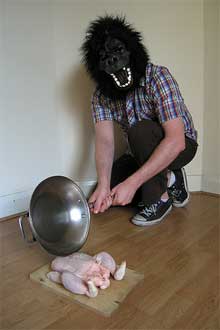 Ian Ferguson's projects at Design Products - Platform 11 (Royal College of Art in London) this year have explored tools, in particular the way that they are never objects unto themselves, but imply a network of human intentions, material objects and social relationships. Hence when designing a tool you are setting up a dialogue between all the agents in the network that the tool taps into.
Ian Ferguson's projects at Design Products - Platform 11 (Royal College of Art in London) this year have explored tools, in particular the way that they are never objects unto themselves, but imply a network of human intentions, material objects and social relationships. Hence when designing a tool you are setting up a dialogue between all the agents in the network that the tool taps into.
It took me a while and a long explanation text from the designer to understand the relationship between some of his projects: the caveman ones and those that deal with advanced fabrication techniques: "For me they are all related to questions that I have about what the appropriate role of technology in our lives is and how I, as a designer, can reconcile my dislike of overconsumption with my belief in science and technology."
Nouveau Neolithic starts with A Man and His Pan!
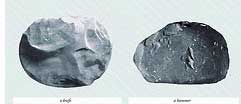 A neolithic knife and a hammer appear almost identical to modern eyes; two fist-sized rocks with only the slightest formal difference between the two. Their functions are defined as much by how neolithic man chose to use them as by any fundamental formal differences.
A neolithic knife and a hammer appear almost identical to modern eyes; two fist-sized rocks with only the slightest formal difference between the two. Their functions are defined as much by how neolithic man chose to use them as by any fundamental formal differences.
Modern homes are full of specialized objects that extend far beyond the simple neolithic hammer & knife pairing, but how many of them are intrinsically different and how many are only differentiated by our collective agreement to perceive them as different?
Following an analysis of new kitchen tools, Ian Ferguson determined that the frying pan can perform most of the tasks that all our normal household tools can. It is just a matter of learning to look at it as an object of unknown potential rather than a âfrying pan.â Design is as much an action as it is an object.
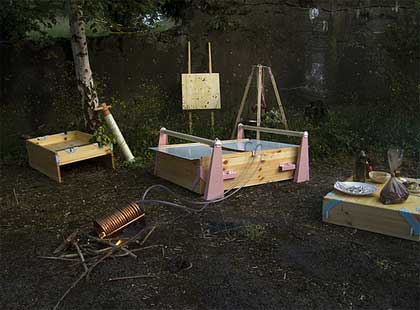
Nouveau Neolithic - range
Nouveau Neolithic is a range of tools for post-apocalyptic gourmands to allow us to cope with food and energy scarcity while preserving pleasure and dignity in our daily lives. They allow small groups to produce refined gourmet cuisine from simple staples and foraged foods, minimizing energy consumption by replacing electrical power with collective labour. The object of the project is to try and find strategies for using objects to promote positive social responses to a scenario where climate change and energy supply depletion has brought an end to cheap food imports and everything except the most basic of staple foods have moved out of reach of all but the super-rich.
How will the middle class gourmands, who have become so used to their food blogs and gastropub meals, preserve the pleasure and dignity of having a fine food culture? Drawing inspiration from the communal cooking practices that emerged during the Depression and World Wars in America and Europe, Nouveau Neolithic proposes a new take on sustainability by focussing on transforming the limitations imposed by global warming and resource depletion into positive new social practices.
The range consists of a series of portable kits that allow for food preparation and cooking.
The Al Fresco Bain Marie is a simplified version of the sous-vide cooking systems found in commercial kitchens, where food is cooked sealed in plastic bags in a water bath to very precise temperatures. Instead of relying on sophisticated electronics to maintain these temperatures, the Al Fresco Bain Marie relies on human observation and intervention.
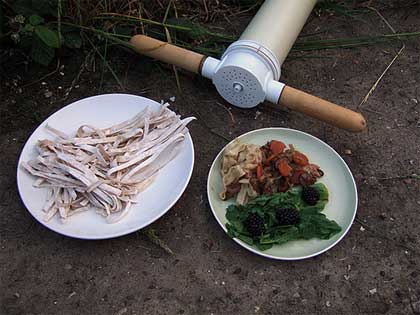
Couples Pasta Extruder with Rabbit Pappardelle
The Couple's Pasta Extruder is a simple pasta extrusion machine that consists of a wooden plunger and metal tube with extrusion head at one end. One person holds the extrusion head while the other pushes on the plunger to force the pasta out.
Team Food Processing allows for puréeing and chopping foods. A large wooden pestle and metal mesh mortar are used to purée food, and an adjustable hopper and guillotine knife are used to slice, chop and dice.

Team Food Processor with Blackberries and Elderflower Custard
In addition to all the objects, Ian Ferguson also designed a number of menus and recipes to be made using foraged foods and the tools kits. Example: Pappardelle with Rabbit, Field Mushrooms & Thyme.
Images courtesy of the designer.
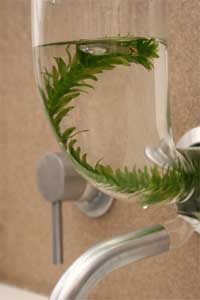 Marei Wollersberger was showing two projects at the Great Exhibition. The first one was a development of the Biosafe Apparatus she had first presented a few months ago at the Design Interactions interim show.
Marei Wollersberger was showing two projects at the Great Exhibition. The first one was a development of the Biosafe Apparatus she had first presented a few months ago at the Design Interactions interim show.
Biosafe Habitat explores peopleâs hopes and fears related to emerging technology and our increased safety demands.
Focusing on perceived domestic security in times of potential bioterrorist and chemical attacks, Marei's proposal is to use animals as biosensors, that would allow us to check if our home is really safe from external influences. The idea was inspired by miners who used to take canaries with them to monitor the air quality. When the bird died, they knew the air was toxic and they had to retreat from the mine.
To protect the home from attacks on the water supply, fish as biosensors would be living in the water supply system, more precisely in a kind of aquarium located by the tap.
The fish would have to be a GloFish, a brand of genetically modified zebrafish that starts fluorescing when exposed to contamination. Although not originally developed for ornamental home uses, it is the first GM animal to become publicly available (only in certain countries such as the US) as a pet. This could lead to new behaviours such as presenting your guests with a jug of water with a living fish swimming inside it as a sign that you are offering them safe water.
Now how about the rest of the house?
Cockroaches have hairy feet that can pick up much faster than humans the smallest traces of everything from airborne contamination to biological and chemical agents.
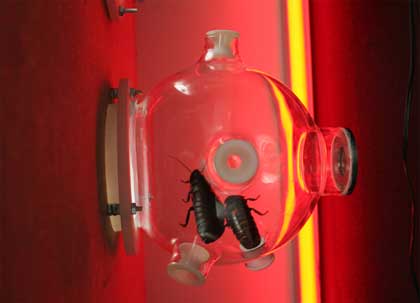
Madagascar Hissing Cockroaches are the prefered species. A special nesting box would have to be installed in the house as the insect require a certain amount of humidity and heat to breed and thrive. You'd just need one or two of them so it is not as if you are opening the door to an un-controllable pest. In case of suspicion, the animals can be released and their hairy feet will collect evidence of any trace of potentially harmful substance. The home owner would them catch them back (apparently the roaches find the smell of coffee irresistible) and check if the substances under their feet present traces of potentially harmful substances.
More images.
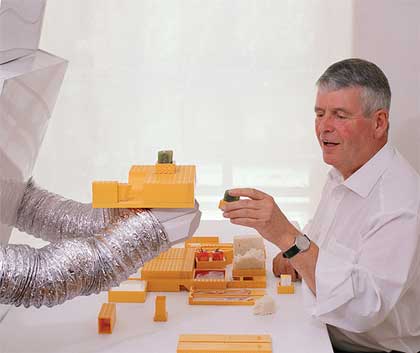 Many industrialized countries are about to suffer of the consequences of an ageing society. The rising costs of social benefits and a decrease in healthcare workers has resulted in the elderly and handicapped community growing lonely and falling into despair. Japan is looking at technology, in particular robotics and cybernetics, to solve some of its social problems.
Many industrialized countries are about to suffer of the consequences of an ageing society. The rising costs of social benefits and a decrease in healthcare workers has resulted in the elderly and handicapped community growing lonely and falling into despair. Japan is looking at technology, in particular robotics and cybernetics, to solve some of its social problems.
Martin Postler developed the âLife/Machine â" Scenes from a roboted Lifeâ project to investigate the possibility of creating an alternative society in which humans and their alter egos, the robots, can live together in the domestic space. The project started in September 2006 in Japan, where he had undertaken a research residency at the Kyoto University of Arts. He then pursued the project at the Design Products department of the Royal College of Art in London.
The project explores questions such as: Can humanity and technology work together in a factory-like symbiosis, where help and assistance result in a machined life? How much freedom would we have to give up to accommodate the robots needs? How much would we have to bend, how much would we have to adjust to live in such an intimate relationship?
In Martin's near future world the robot has similar physical proportions as the human, but works on common binary computational logical logics. His intelligence and skills are very limited but that doesn't prevent it from being involved in several every day life procedures to assist and serve the human being in a defined household surrounding.
The project is divided into 3 different areas, representing 3 different everyday routines.
Part 1 - Nutrition
The emphasis lies on the pure physical and interactive need of the human to prepare, store and process food and on the other side on basic robot intelligence attributes like order, color recognition, formal and geometric repetition and reduced functional complexity.
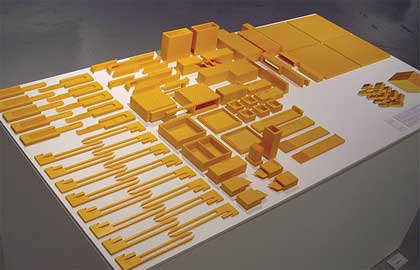
Robot kitchen tools Kyoto 2006
Even a very clean kitchen would be way too complicated for robots as they exist right now. Colors, shapes, functions, order and even the whole concept of a kitchen would have to change. The designer therefore imagined a product system which consists of 74 single elements. All elements can be build up to product structures or âfunctional landscapesâ accommodating the intellectual and functional necessities of both man and robot.
Part 2 - Hygiene
Intimate moments in the robotic household: the robot is brushing the humans teeth, waxing his ears and give him a shaving of his choice.
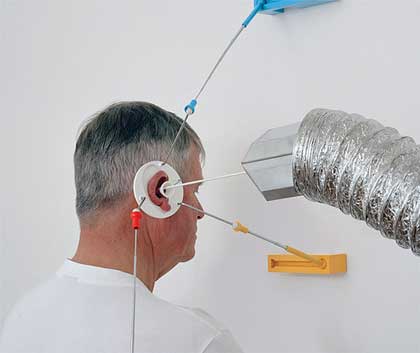
Robotic ear wax
Martin designed the tools which would make these interactions possible. The main focus lies on the physical exposure and almost humiliating adjustment of the human protagonist to his robotic twin, resulting in an automated morning routine.
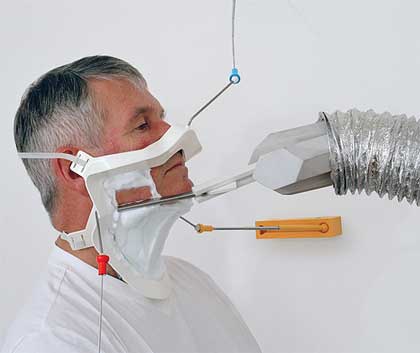
Robotic shaving
Part 3 - Leisure
This chapter presents an even more satirical aspect of this relationship by developing a range of âschoolyard gamesâ which are
modified to accommodate both robots and humans needs. The designer attempted to narrow down the human â" machine conflict to more bizarre and almost tragicomic scenery referring to more philosophical aspects of the theme.
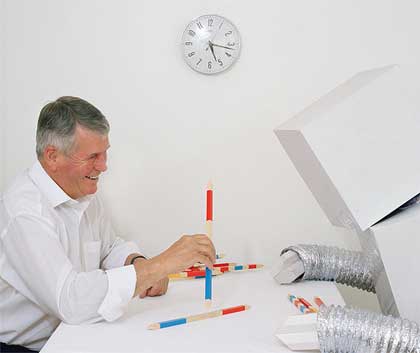
The project points on the myths of technological development in a rather satiric and ironic way, explains Martin Postler. By choosing a âwhat ifâ situation, a parallel world, a realistic scenario I intend to confront the protagonist with his own creation, his technological mirror. On the other side the project celebrates the human condition and the fascination and commitment towards technological progress, the ongoing drive to recreate ourselves.
All images courtesy of Martin Postler.
Blogged by Hack41
. . . . . . . . . . . . . . . . . . . . . . . . . . . . . . . .

0 Comments:
Post a Comment
<< Home